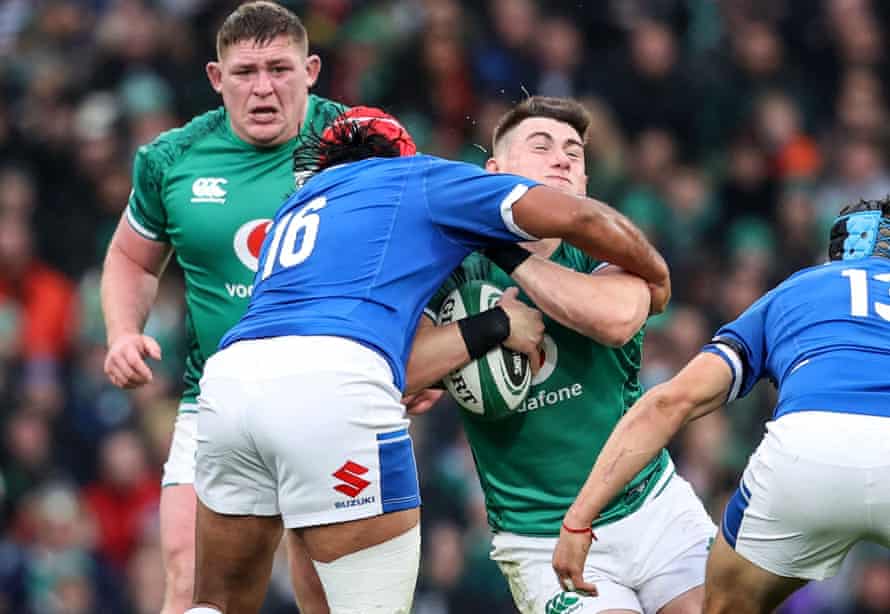Everyone who enjoys rugby union will have winced at some stage over the weekend. For many it will have been the moment when Italy’s admirable captain, Michele Lamaro, discovered his team would, by the dispiriting letter of the law, have to soldier on with 13 men for an hour against one of the world’s top sides. Alternatively, it might have been the footage of a staggering Tomas Francis rejoining the fray at Twickenham having exhibited precisely the kind of ataxia symptoms that should see players permanently removed.
Or maybe it was the frequent long stoppages in both games. Or the time-consuming reset scrums. Or the constant peep of the referee Mike Adamson’s whistle during England v Wales. Or the distracting ebb and flow of water carriers entering the field of play? Or the lack of consistency when the Irish forward Ryan Baird caught his Italian opponent Marco Zanon with the same kind of upright tackle which had led to the Azzurri’s replacement hooker, Hame Faiva, being handed a red card.
The Breakdown: sign up and get our weekly rugby union email.
As it happened the grimmest development of all, Ukraine excepted, was still to come. And shocking it was, too. The preliminary findings of a study by the Australian Sports Brain Bank into the long-term ramifications of concussion in sport have been published, with chronic traumatic encephalopathy discovered in the brains of more than half of the deceased sportspeople examined, including three under the age of 35. Of 21 brains posthumously donated since 2018 by people involved in sports with a risk of repetitive head injury, 12 were found to have CTE lesions while all but one showed some form of neurodegeneration.
Which just leaves us with the stark testimony of the former Ireland flanker David Corkery in a powerful, sensitively written interview with Gary Doyle on the RugbyPass site last week. “It gives me shivers when I see the hits in the modern game,” Corkery revealed. “I got so many concussions, I lost count. I’ve suffered from depression for years. The black dog is always in the corner, ready to bark. My depression, is it related to those head injuries? I don’t know.”
Rugby clearly has plenty to commend it, too. Where would we be without the Six Nations? But only someone with their eyes and ears closed can possibly fail to appreciate the narrow ledge upon which the sport is now perched. Fail to take the possibility of brain injury seriously enough and the sport is doomed. Go too far the other way in terms of arcane, bolted-on laws and endless penalties and how many people will still want to watch it? It is a precarious position and rugby’s next moves will be critically significant.
Because everything we are seeing is intertwined as far as rugby’s public image goes. The Ireland v Italy fixture on Sunday descended into barely watchable farce partly because health and safety has led to the laws governing front-row replacements becoming properly byzantine. Even impressive, multilingual national captains are struggling to grasp them. But how, exactly, does protecting player welfare and upholding the integrity of the game tally with forcing an inferior side to soak up yet more punishment having already lost their first‑choice hooker to a genuine tournament-ending injury?

Had Italy fibbed on the teamsheet they must submit 48 hours before kick-off and officially nominated a notional third hooker, they would have been able to retain 14 men. Instead, they were effectively penalised for their honesty and, with no way of avoiding uncontested scrums, had to forfeit another player. The entire championship table could be compromised as a result. What if Ireland now win the title on points difference? Italy might have conceded 50 points anyway but, in years to come, the result on Sunday should carry a permanent asterisk.
The whole episode felt wrong. Just as the recent head assessment failures which have even caused some of the sport’s senior officials to roll their eyes in exasperation. Along with the Francis episode, rightly described by the lobby group Progressive Rugby as a “clear and fragrant breach” of head injury assessment protocols, we all continue to await the outcome of the independent investigation into the incident late in the Italy v England Under‑20 game when a visiting match doctor seemed to be seeking to persuade the female referee to allow a possibly injured English player to stay on the field rather than go for an HIA.
The longer the uncomfortable silence lasts, the more it will feed the suspicion there is something to hide. Perceptions matter and there is an increasing onus on governing bodies and unions to be as squeaky clean as the players over whom they preside. Many of them, meanwhile, are already understood to be in agreement that endless match interruptions risk “killing the spectacle”. Expect the water carrier regulations, in particular, to be significantly tightened in May.

The Dublin shambles, though, is being regarded as an extreme set of circumstances unlikely to be repeated. Which, for now, suggests no law rewrite. Hmm. How many casual viewers had a clue what was going on, never mind the supposed experts? Which raises the question of whether rugby’s stuffy, bloated law-book is entirely fit for purpose.
In truth World Rugby and the Six Nations were lucky on two counts at the weekend: first, that Italy made such a gallant fist of impossible circumstances; and second, that Francis did not sustain another obvious heavy blow on his return. But what about all those aggregated subconcussive hits we can’t see? The last thing rugby needs just now is any more own goals.
